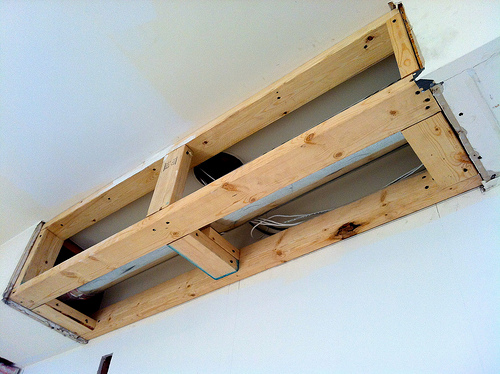Also known as a bulkhead, bump out, or drop-down, a soffit is an architectural element used to hide ductwork and other ceiling obstructions. It can also add depth to an otherwise flat ceiling – making the room appear longer and wider than it actually is. Stylish and functional – turn a plain, boxy room into an appealing and inviting space with this architectural wonder.
Soffit 101
A soffit is a box framed with wood and covered with drywall or wall board that encloses existing ductwork, piping, or beams. Soffits are usually built in basements to hide pieces that are not easily moved. Kitchen soffits are used to lower cabinets from a tall ceiling. In home theaters, soffits can add style and function to a space. Home theater ceiling soffits are useful for mounting recessed lighting, improving room acoustics, holding a projector or speakers, and running A/V wires. Additionally, home theater ceiling soffits prove helpful when doing a retrofit installation when a room is already finished.
Design and Form
The rule of thumb is to make a soffit at least 8 inches deep, while the minimum width requirement is 28 inches – especially if you plan to mount recessed lights and hold ceiling speakers. Allow for an overhang at the uncovered ends of soffit runs. If you want to cover ductwork, use a U-shaped former by screwing a series of 2×3’s or 2×4’s to the floors joists. You can build soffits wider or taller to suit larger rooms.
Building the Soffit
Figure out whether the item you’re enclosing with a soffit can be relocated or moved higher. You might need opinions from an HVAC expert, plumber, or electrician. Oftentimes, it’s more beneficial to move ductwork (or water pipes) rather than build a soffit.
Screw or nail 1×4’s to the back of upper and lower 2×2 runners – fashioning a ladder-like construction. Position a vertical support at each end and about 15-16 inches spaces on center throughout. Make sure your construction is flat, rigid, and square. Use a table saw to keep your cuts evenly straight.
Mark a score line at least 12 inches below the ceiling and parallel to the wall onto the bottom of the joists. Use a chalk, tape measure, and a spirit level. If you’re framing an L-or U-shape soffit, set up the first part parallel to the longest wall, then square the other soffit legs to it.
When securing the plywood, push it flush with the joist and install just one nail (pushing it too tight may create squeaks). Once leveled, secure the plywood to the horizontal nailer.
Screw or nail 1×4 straight supports to the top edge of the wall runner and the lower runner. Allow at least a 48-inch gap on the center. Ensure that the soffit stays square. You can put sound absorbing materials in the soffit around the wiring and speakers. Cover the front and bottom of the soffit with drywall. Remember that every forth soffit supports the edge of at least two sheets of drywall. You can also run AC power through the soffit to provide electrical outlets or wiring to home theater sconces.

